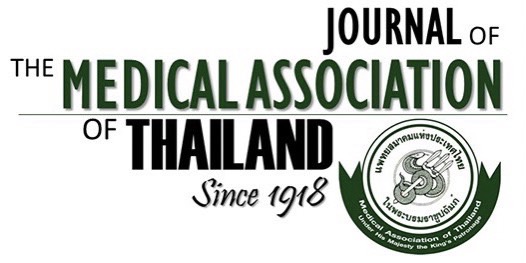The Comparative Study of the Efficacy between the Reinforced PTFE and the Non-Reinforced PTFE in the Forearm Arteriovenous Access for Hemodialysis
Lakchai Wichawut MD*, Suthas Horsirimanont MD*, Wiwat Tirapanich MD*, Sopon Jirasiritum MD*, Surasak Leela-Udomlipi MD*, Piyanut Pootracool MD*, Nutsiri Kittitirapong MD*, Sakda Arj-Ong Vallibhakara MD, PhD**
Affiliation : * Division of Vascular Surgery and Transplantation, Ramathibodi Hospital, Mahidol University, Bangkok, Thailand. ** Section for Clinical Epidemiology and Biostatistics, Ramathibodi Hospital, Mahidol University, Bangkok, Thailand
Background : Common problems with arteriovenous hemodialysis access were early graft thrombosis, prolong hemostasis
time resulted from improper technique in compression. Reinforced PTFE graft offered stable, visualized contour which might
decreased these problems.
Objective : This objective of this study was to evaluated the efficacy between the reinforced Polytetrafluoroethylene (PTFE) and
the non-reinforced PTFE as the prosthetic graft in the forearm arteriovenous access in the aspects of 6-month primary
patency, numbers of cannulation attempts, time to successful cannulation, hemostatic compression time and satisfaction level
of dialysis nurses.
Material and Method: Sixty patients with end-stage renal disease suitable for forearm arteriovenous graft creation at
Ramathibodi hospital were randomized to Non-reinforced and Reinforced PTFE graft access group. Demographic data were
collected. Questionnaires were sent to dialysis nurses whom in-charge for access cannulation. The informations included date
of cannulation, numbers of cannulation attempts on each hemodialysis session, experience of dialysis nurse, hemostatic
compression time and satisfaction scores for the access in the first month of hemodialysis. Post-operative follow-up scheduled
for the assessment of the patency, the forearm circumference at 2nd week and 4th week. The complications were recorded.
Results : The Reinforced PTFE group demonstrated comparable 6-month primary patency to non-reinforced PTFE group
(100% vs. 100%), shorter time to successful cannulation (22 vs. 31.5, p<0.05), lower numbers of cannulation attempts (1 vs.
1.1, p<0.05), shorter compression time (5.64 vs. 7.61, p<0.05). Experience didn’t affect numbers of cannulation attempts on
Reinforced PTFE group. There were no significant differences in the increased in Forearm circumference at postoperative
period (2nd week and 4th week) compared with preoperative period between the two groups.
Conclusion : Reinforced PTFE graft had a comparable 6-month primary patency and complication rate with shorter duration
of successful cannulation.
Keywords : Reinforce PTFE, Time to first cannulation, Patency rate, Hemodialysis



